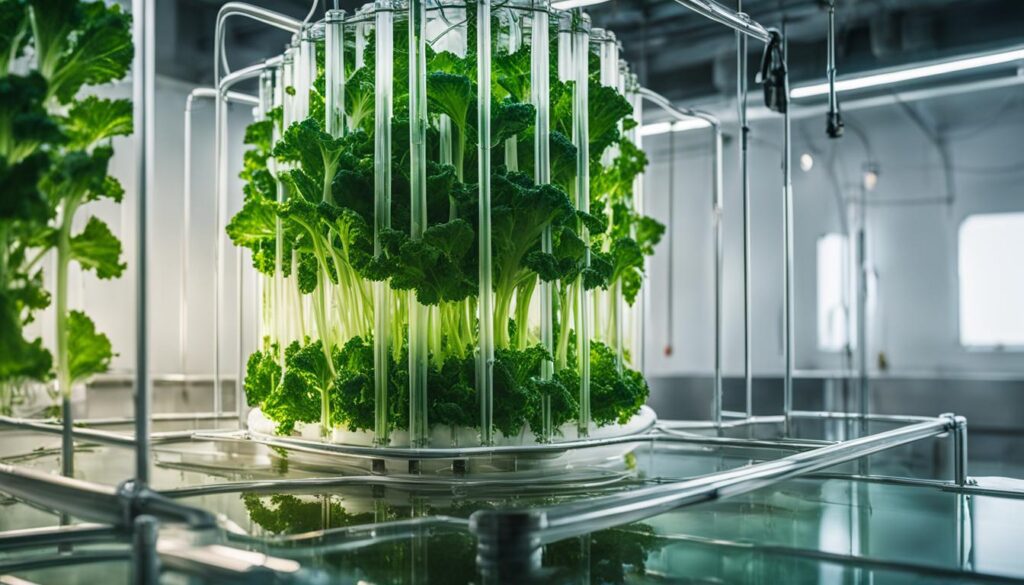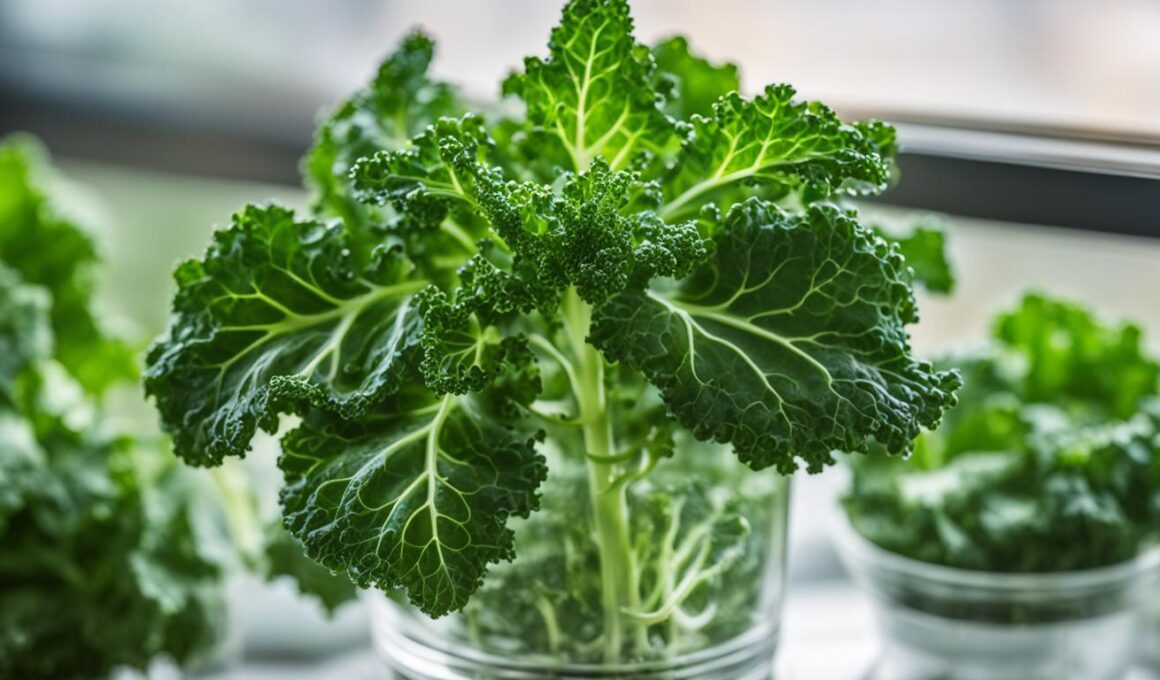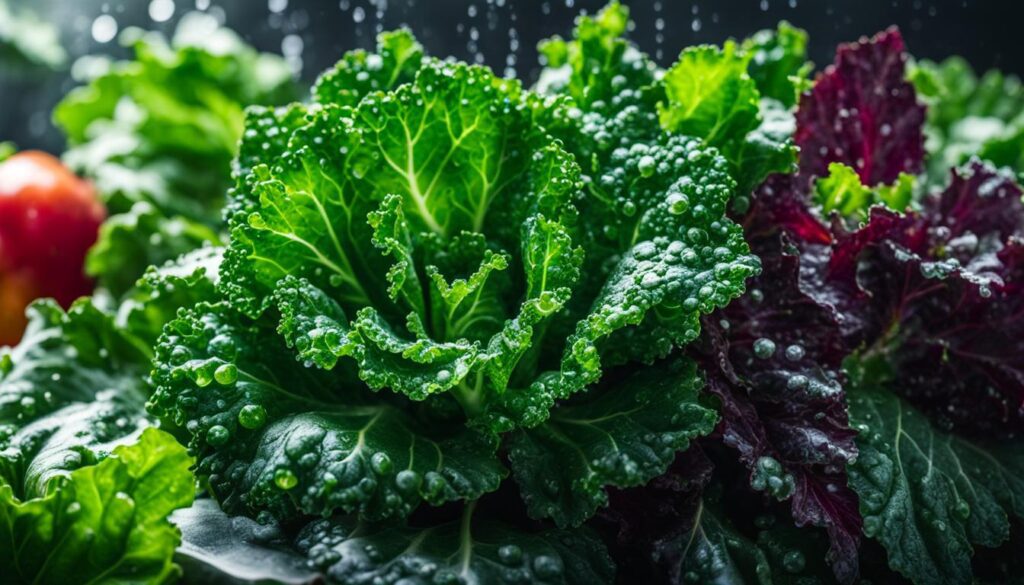Welcome to our guide on growing kale hydroponically! If you’re interested in cultivating this versatile and nutrient-rich crop indoors, you’ve come to the right place. Hydroponics provides an excellent system for starting kale seeds and offers complete control over the growing environment. Whether you’re a seasoned hydroponic gardener or a beginner, this article will provide you with all the information you need to successfully grow kale hydroponically.
Post Summary:- Growing kale hydroponically allows you to harvest early and enjoy the nutrient-dense nature of this green powerhouse.
- Hydroponic kale is as nutritious as traditionally grown kale and offers the advantage of complete control over the growing process.
- Choosing the right variety of kale is essential for hydroponic cultivation, and options include Siberian Kale, Red Russian Kale, Lacinato Kale, and Dwarf Green Curly Kale.
- Germinating kale seeds can be done in a suitable container using seed germination soil or vermiculite particles.
- There are different hydroponic systems available for growing kale, including Deep Water Culture (DWC) and the Kratky method.
Benefits of Growing Kale Hydroponically
Growing kale hydroponically offers numerous benefits that make it an attractive option for home gardeners and commercial growers alike. Let’s explore some of the advantages of growing kale hydroponically:
1. Early Harvest and Extended Growing Season
When you grow kale hydroponically, you have the ability to harvest your crops earlier compared to traditional soil gardening. Hydroponic systems provide an optimal environment for growth, allowing kale to reach maturity faster. This means you can enjoy fresh, homegrown kale sooner and have an extended growing season year-round.
2. Nutrient-Dense and Chemical-Free Kale
Hydroponically grown kale is just as nutritious, if not more, than conventionally grown kale. The controlled environment in hydroponics allows for precise nutrient delivery, resulting in nutrient-dense greens. Additionally, hydroponic systems eliminate the need for pesticides, herbicides, and other harmful chemicals often used in traditional soil gardening. This means you can enjoy healthier, chemical-free kale straight from your hydroponic setup.
3. Complete Control over the Growing Process
One of the key advantages of hydroponic gardening is the complete control it offers over the growing process. From the nutrient solution to the lighting and temperature, every aspect can be fine-tuned to create an ideal environment for kale growth. This level of control allows you to optimize growth conditions, resulting in higher yields and healthier plants.
4. Versatility and Independence
Growing kale hydroponically gives you the flexibility to cultivate this nutritious leafy green regardless of outdoor conditions. Whether you have limited space or live in an area with harsh climates, hydroponic systems provide a controlled environment that allows kale to thrive. By growing kale hydroponically, you can become more self-sufficient and enjoy the satisfaction of harvesting your own fresh produce, all year round.
In summary, growing kale hydroponically offers a range of benefits, including early harvests, nutrient-dense greens, complete control over the growing process, and increased independence. With these advantages, it’s no wonder that hydroponic kale cultivation is gaining popularity among gardeners and farmers alike.
Choosing the Right Variety of Kale
When it comes to growing kale hydroponically, choosing the right variety is essential. Different kale varieties have distinct characteristics, including appearance, leaf texture, and taste, allowing you to select the perfect option for your hydroponic setup.
Here are some of the best kale varieties for hydroponics:
- Siberian Kale: This variety has deep green, curled leaves and is known for its hardiness and cold tolerance.
- Red Russian Kale: With beautiful purple stems and frilled leaves, this variety adds a touch of color to your hydroponic garden.
- Lacinato Kale: Also known as dinosaur kale, this variety has long, dark green leaves with a bumpy texture.
- Dwarf Green Curly Kale: This compact kale variety is perfect for smaller hydroponic systems and has the familiar curly leaves.
Each variety offers its own unique flavor and visual appeal. Consider your preferences and growing conditions when choosing the right kale variety for your hydroponic garden.
| Variety | Appearance | Leaf Texture | Taste |
|---|---|---|---|
| Siberian Kale | Deep green, curled leaves | Crunchy | Mild, slightly sweet |
| Red Russian Kale | Purple stems, frilled leaves | Tender | Earthy, slightly sweet |
| Lacinato Kale | Long, dark green leaves | Bumpy | Rich, slightly bitter |
| Dwarf Green Curly Kale | Compact, curly leaves | Crunchy | Mild, slightly peppery |
By choosing the right kale variety, you can ensure a successful and flavorful hydroponic kale harvest.
Germinating Kale Seeds for Hydroponics
Germinating kale seeds is the crucial first step in successfully growing kale hydroponically. With the right conditions and care, you can ensure strong, healthy seedlings that will thrive in your hydroponic system.
Choosing the Right Seeds
Before germinating kale seeds, it’s important to choose the right variety. Look for seeds specifically labeled for hydroponic or indoor growing. These seeds are often treated to enhance germination rates and adaptability to hydroponic systems.
Preparing the Germination Container
Start by selecting a suitable container for germinating your kale seeds. You can use seed trays, peat pots, or even recycled containers with drainage holes. Fill the container with a high-quality seed germination soil or vermiculite particles.
The Germination Process
After preparing the container, it’s time to sow the kale seeds. Make small indentations in the soil or vermiculite, approximately ¼ inch deep. Place one or two seeds in each indentation and cover them lightly with soil.
Maintain a consistent level of moisture and humidity in the germination environment. Cover the container with a plastic dome or use a plastic bag to create a greenhouse effect. Keep the temperature between 18°C and 24°C to promote optimal germination.
Within 7 to 14 days, you should start to see the kale seeds germinate and tiny seedlings emerge. At this stage, it’s important to remove the plastic cover and provide adequate lighting for the seedlings. Position grow lights or place the container in a well-lit area to ensure proper growth and development.
| Germination Tips for Kale Seeds |
|---|
| Keep the soil or vermiculite consistently moist but not waterlogged to prevent root rot. |
| Monitor the germination environment regularly to maintain the desired temperature and humidity. |
| Thin out the weaker seedlings, leaving the strongest ones to develop further. |
| Transplant the seedlings to the hydroponic system once they have developed a few true leaves. |
Hydroponic Systems for Growing Kale
When it comes to growing kale hydroponically, there are a few different systems you can choose from. Two popular options are the Deep Water Culture (DWC) system and the Kratky method. Let’s take a closer look at each of these systems and their benefits.
DWC System
The Deep Water Culture (DWC) system is a commonly used hydroponic system for growing kale. This system involves suspending the plant’s roots in a nutrient-rich water solution. The plants are supported by floating rafts or placed in net pots with their roots submerged in the water. The continuous supply of oxygen and nutrients helps the kale plants thrive.
Kratky Method
The Kratky method is another popular option for growing kale hydroponically. This method is a passive hydroponic system that requires no electricity or water circulation. The plants are placed in net pots filled with a growth medium, such as coco coir or perlite. The roots of the plants are partially submerged in a deep-water reservoir, allowing them to take up water and nutrients as needed.
Both the DWC system and the Kratky method have their advantages and disadvantages. The choice between them depends on factors such as your preferences, available space, and the specific needs of your kale plants. Experimenting with different systems can help you determine which one works best for you.

In conclusion, hydroponic systems provide an efficient and controlled environment for growing kale. Whether you opt for the DWC system or the Kratky method, you can enjoy the benefits of fresh, homegrown kale throughout the year.
Nutrient Solution and Lighting for Hydroponic Kale
When growing kale hydroponically, it is crucial to provide the plants with the right nutrient solution and lighting conditions to ensure their optimal growth and development. Kale requires specific nutrients for different stages of its growth cycle. For vegetative growth, it needs a nutrient solution with a higher nitrogen content, while during root development, phosphorus becomes essential. Regular monitoring of the electrical conductivity (EC) and temperature of the nutrient solution is vital to maintain the proper nutrient balance and ensure healthy root growth.
In addition to the nutrient solution, proper lighting is essential for the successful growth of hydroponic kale. Artificial lighting can be used to provide the necessary light spectrum for photosynthesis. For kale, a combination of blue and red light wavelengths is recommended. Blue light promotes leaf development and canopy growth, while red light stimulates flowering and fruiting. It is important to provide the plants with the right intensity and duration of light to mimic natural sunlight. A temperature range of 15°C to 25°C is optimal for kale growth, and maintaining consistent temperature levels is critical for ensuring healthy plant development.
| Nutrient Solution for Kale | Lighting Requirements for Hydroponic Kale |
|---|---|
| Nitrogen-rich solution for vegetative growth | Combination of blue and red light wavelengths |
| Phosphorus-rich solution for root development | Proper intensity and duration of light |
| Regular monitoring of EC and temperature | Temperature range of 15°C to 25°C |
By providing the right nutrient solution and lighting conditions, you can ensure that your hydroponic kale plants receive the necessary nutrients and light for their growth and development. This will result in healthy, vibrant plants that yield an abundance of nutritious kale for your enjoyment.
Can I Grow Kale Microgreens Using Hydroponics?
Yes, you can definitely grow flavorful kale microgreens using hydroponics. With this technique, you can provide the ideal conditions for the kale microgreens to thrive, ensuring their rich taste and nutritional value. Hydroponics allows for precise control over water, nutrients, and light, resulting in a faster and more efficient growth process.
Conclusion
In conclusion, growing kale hydroponically provides a range of benefits that make it an excellent option for home growers. With complete control over the growing process, you can ensure optimal conditions for your kale plants, resulting in higher yields and better quality produce. Whether you’re a beginner or an experienced gardener, hydroponic kale is a rewarding endeavor.
By selecting the right variety of kale for hydroponics, germinating the seeds properly, and choosing the appropriate hydroponic system, you can set yourself up for success. Providing the right nutrient solution and lighting conditions will further support the growth and development of your kale plants.
One of the most significant advantages of growing kale hydroponically is the ability to enjoy fresh, homegrown kale all year round. Regardless of outdoor conditions or limited space, you can harvest nutritious kale at any time. So why not give hydroponic kale growing a try and experience the joy of growing your own delicious greens?
Can a Solar Water Pump Be Used for Growing Kale Hydroponically?
Yes, a solar water pump for hydroponics can be used to grow kale hydroponically. This efficient and eco-friendly option can provide the necessary water circulation and aeration for kale to thrive without the use of traditional electricity. With the power of the sun, it’s a sustainable choice for hydroponic gardening.
FAQ
Is kale a suitable crop for hydroponic systems?
Yes, kale is a suitable crop for hydroponic systems due to its adaptability and nutrient richness.
What is the most commonly grown variety of kale in hydroponics?
The most commonly grown variety of kale in hydroponics is Curly kale or Scots kale.
What hydroponic systems are available for growing kale?
There are different hydroponic systems available for growing kale, including Deep Water Culture (DWC) and the Kratky method.
What temperature range is required for the proper growth of kale in hydroponics?
The temperature range required for the proper growth of kale in hydroponics is 16°C to 24°C.
Are hydroponically grown vegetables, including kale, as nutritious as traditionally grown vegetables?
Yes, hydroponically grown vegetables, including kale, are as nutritious as traditionally grown vegetables.
What are the benefits of growing kale hydroponically?
Growing kale hydroponically offers several benefits, including the ability to harvest early as microgreens and the nutrient-dense nature of kale.
Can kale be grown under artificial lighting conditions?
Yes, kale can be grown under artificial lighting conditions, with far-red light being beneficial for increased yield.
How do you germinate kale seeds for hydroponics?
Kale seeds can be germinated in a suitable container using a growth substrate like seed germination soil or vermiculite particles.
What hydroponic systems are commonly used for growing kale?
Deep Water Culture (DWC) systems, including floating rafts and bucket DWC systems, are commonly used for growing kale hydroponically. The Kratky method is another option.
What nutrient solutions and lighting are required for hydroponic kale?
Kale requires specific nutrient solutions with nitrogen for vegetative growth and phosphorus during root development. It can grow well under artificial lighting conditions, with a focus on blue and red light wavelengths.
What are the advantages of growing kale hydroponically?
Growing kale hydroponically offers numerous benefits, such as better control over the growing process, higher yields, and the ability to grow in any season.
How do I choose the right variety of kale for hydroponics?
There are different varieties of kale suitable for hydroponic cultivation, including Siberian Kale, Red Russian Kale, Lacinato Kale, and Dwarf Green Curly Kale. Each variety has distinct characteristics in terms of appearance, leaf texture, and taste, providing options for growers.










